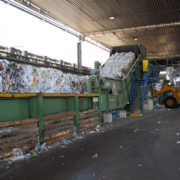Can We Make New Phones From Nothing But Old Ones?
News from PBS
By Marcus Woo on Tue, 12 Sep 2017
As if saying hello, the robot arm waves an iPhone at you. Then, in a few swift maneuvers, the arm and a suite of machinery begin dismantling the phone. First goes the outer casing. Next are the screws and other metal parts, dropping into neat piles. “Meet Liam,” says the voice-over on Apple’s promotional video. Like most things from Apple, Liam looks pretty cool.
Liam is a robot—29 robots working in concert, to be precise—whose job is to take apart iPhones. Apple unveiled the system last year in a bid to more efficiently recycle used phones. But recently, Liam has become part of an even more ambitious plan announced in April: eventually, Apple wants to make new products using only recycled products.
Ideally, that means all your old Apple stuff would eventually become new Apple stuff. There would be no waste and no need to mine for more materials. Such an idea is called a closed-loop supply chain, part of a concept also referred to as a circular economy or a cradle-to-cradle philosophy, which considers the entire lifecycle of a product and was popularized by the architect and designer William McDonough.
In a world with finite natural resources—such as the rare earth metals needed for all your favorite devices—dubious mining practices rife with environmental and human rights problems, and a global appetite for electronics that will only grow, a closed-loop approach may not be just a good idea, but a necessary one. According to a 2014 report from the United Nations, people generated 92.1 billion pounds of e-waste in 2014. That number is expected to balloon to 110 billion pounds in 2018—roughly the weight of 25,000 space shuttles. A closed loop could trim those numbers significantly.
People generated 92.1 billion pounds of e-waste in 2014.
As sustainability has become an industry buzzword, some companies have tried implementing a closed loop. But none are as big and influential as Apple.
While Apple’s goals are laudable, the announcement didn’t exactly include a detailed plan—drawing some skepticism from experts. “It didn’t make people in the industry really excited because, well, you’re not looking at what it’s going to take to do that,” says Carole Mars, the senior research lead for The Sustainability Consortium at Arizona State University.
In fact, no one’s ever achieved a true closed loop on the scale of Apple’s ambitions. And even the company admits they’re not sure how it’ll be done. “We’re actually doing something we rarely do, which is announce a goal before we’ve completely figured out how to do it,” said Lisa Jackson, Apple’s vice president of environment, policy and social initiatives and former head of the EPA, told VICE News in April.
The challenges, to say the least, are many.









